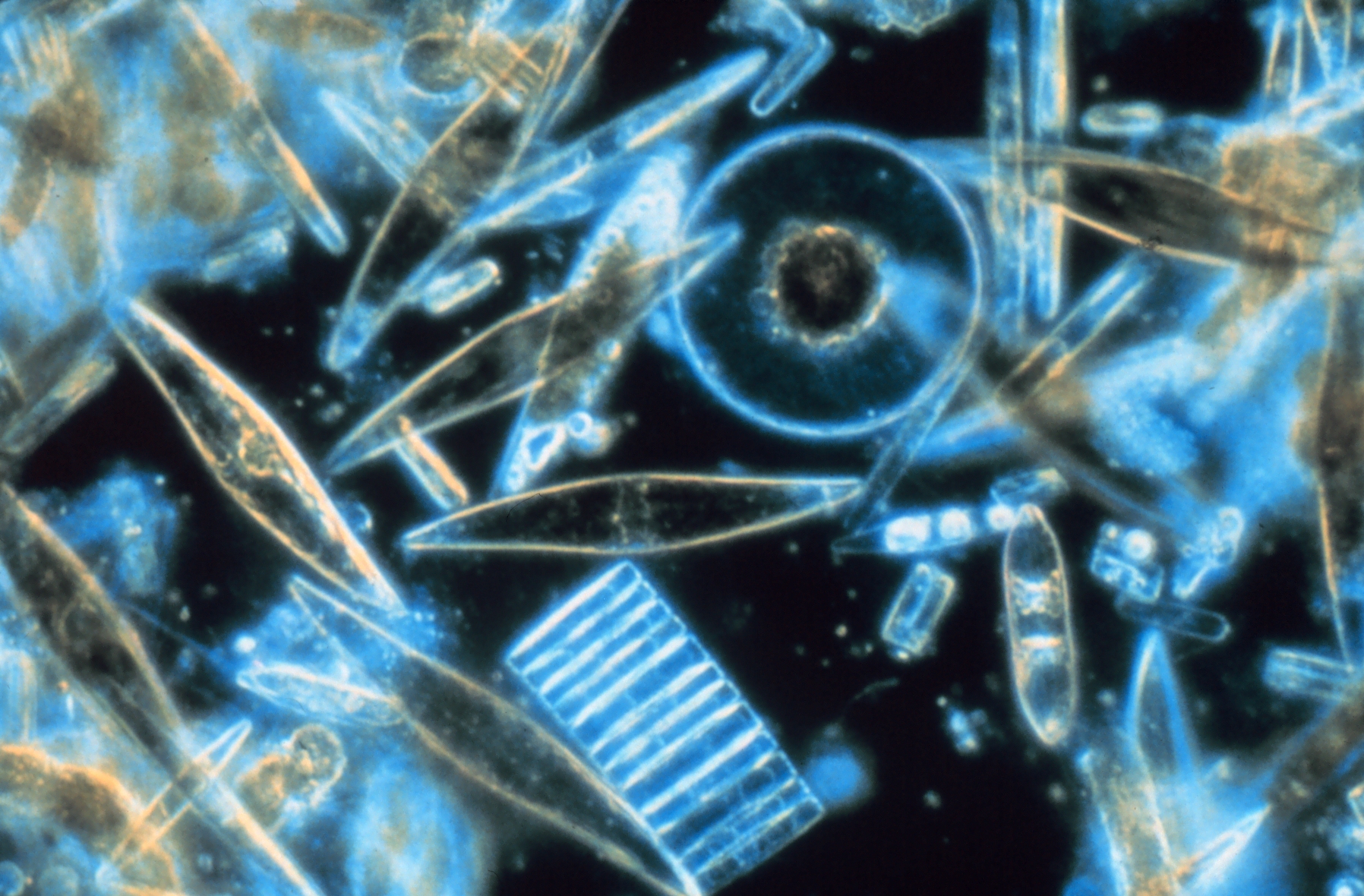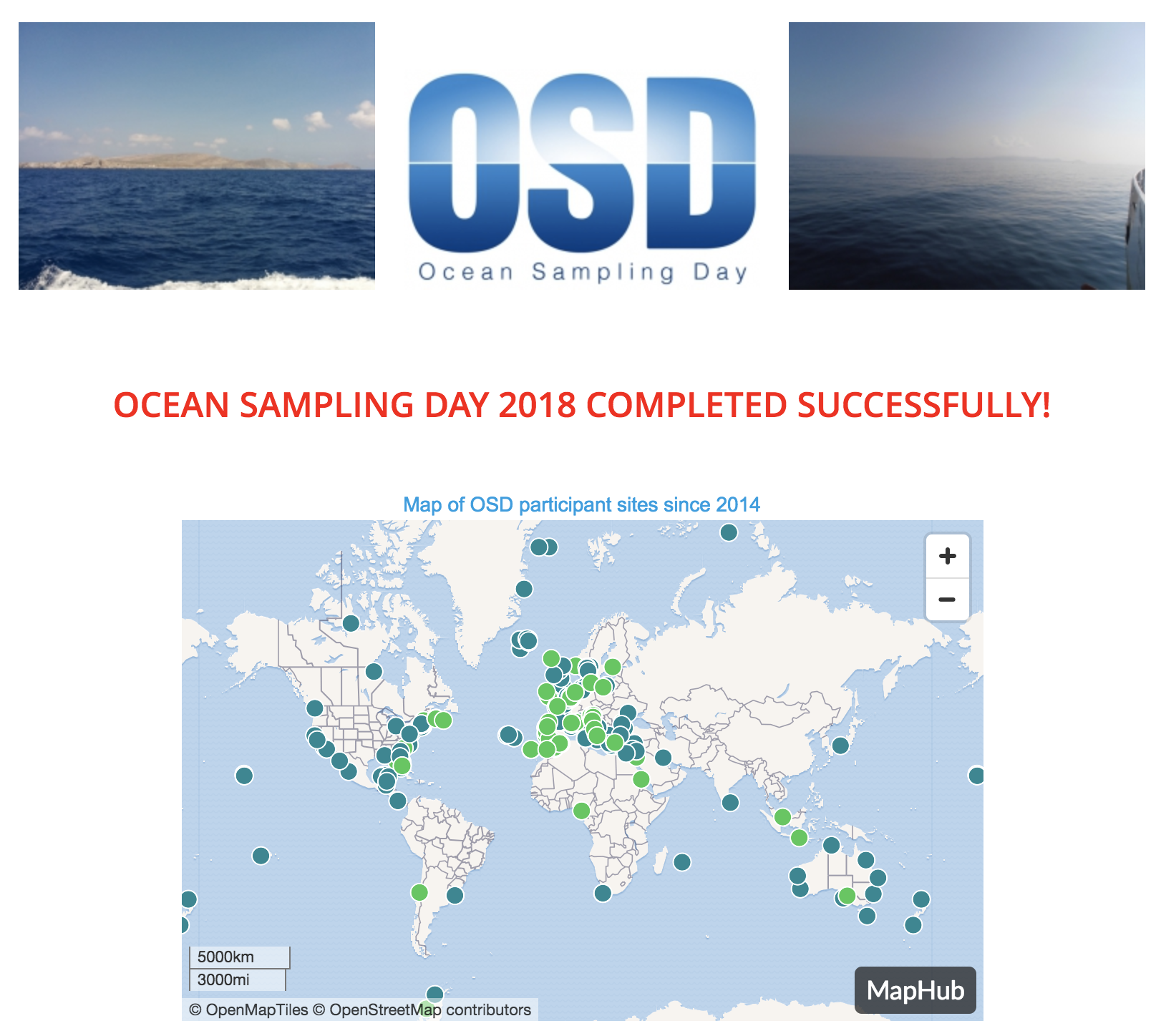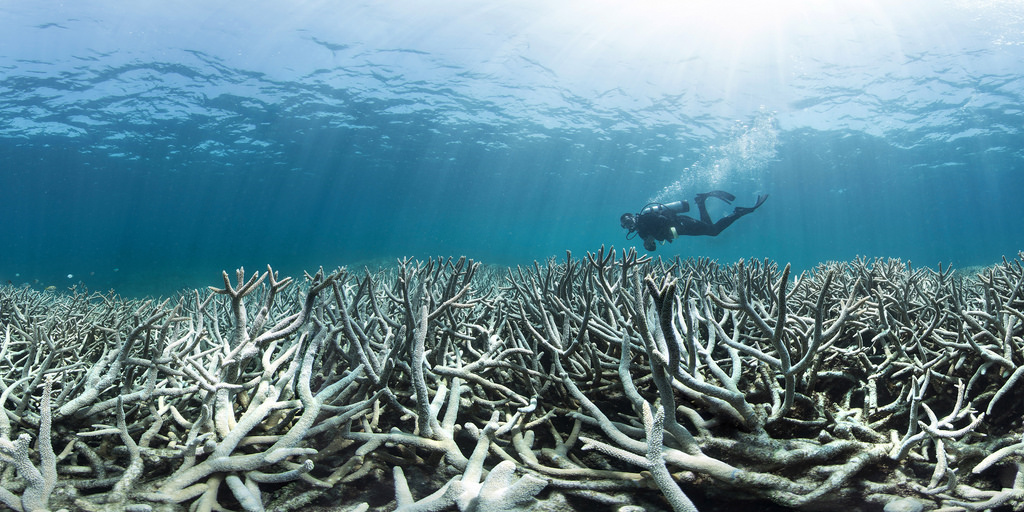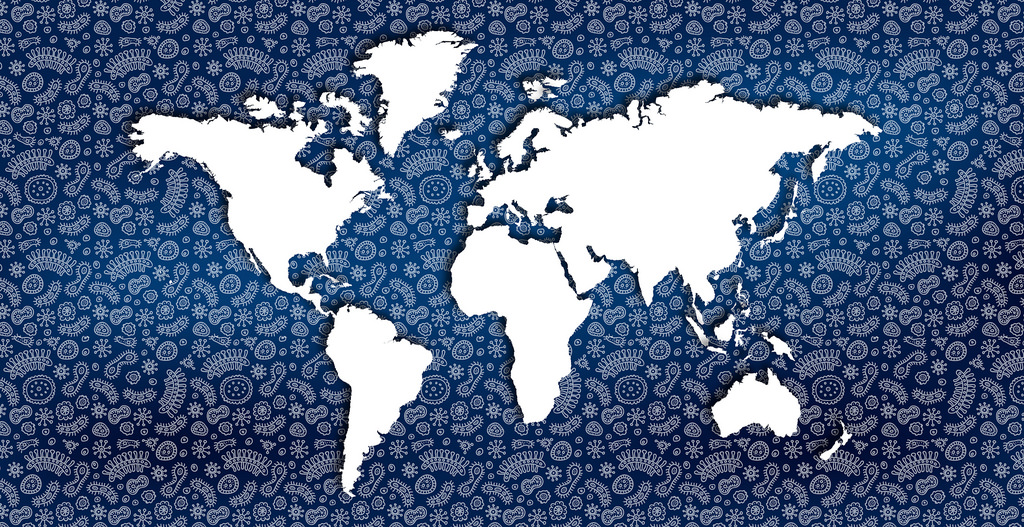"If the last blue whale choked to death on the last panda, it would be disastrous but not the end of the world. But if we accidentally poisoned the last two species of ammonia-oxidizers, that would be another matter. It could be happening now and we wouldn't even know…"
— Microbiologist Tom Curtis in Nature, 2006
Most marine microbes are marine organisms too small to be seen by the unaided human eye (that is, roughly less than 0.1 mm). They make up 98 percent of ocean biomass, are the foundation of all marine food webs, and are a major driver of most of Earth’s biogeochemical cycles, including those of carbon, nitrogen, oxygen, and phosphorus (not to mention those of sulfur, hydrogen, sodium, potassium, magnesium, calcium, and chlorine).
 Microbes are found in all marine environments, from surface waters to abyssal depths, from coastal to offshore regions, and in specialized niches such as coral reefs and hydrothermal vents. Marine microbes are extraordinarily diverse – consisting of bacteria, archaea, protists, fungi, and algae, as well as the viruses associated with these taxa. A single liter of seawater can contain more than a billion microbes representing thousands of different types.
Microbes are found in all marine environments, from surface waters to abyssal depths, from coastal to offshore regions, and in specialized niches such as coral reefs and hydrothermal vents. Marine microbes are extraordinarily diverse – consisting of bacteria, archaea, protists, fungi, and algae, as well as the viruses associated with these taxa. A single liter of seawater can contain more than a billion microbes representing thousands of different types.
With this seemingly endless list of superlatives, you would think the ocean management and conservation communities would be talking about microbes all the time. But we don’t. In this issue of MEAM, we catch up with some of the latest news and research on marine microbes (specifically marine bacteria and viruses) and their influence on marine ecosystems. We also hear from microbial experts about what marine managers and conservationist practitioners should know about marine microbes in the systems in which they work.
The things we know we don’t know
- Despite microbes’ ubiquity, there are many fundamental aspects of their ecology that we do not yet have a good handle on, including the full range of types of microbes in marine ecosystems and the full range of roles they play in those systems. There is not even general agreement on what would constitute a “species” of microbe.
- One reason for this is that marine microbes are notoriously difficult to culture… They depend on complex, highly interactive communities that are difficult to replicate in a laboratory setting.
- Our knowledge is growing rapidly, however, due to the recent development of metagenomics (the study of DNA recovered directly from environmental samples), as well as advances in remote sensing and sampling technologies (keep reading for more on this).
How we’re getting to know marine microbes

- The International Census of Marine Microbes (ICoMM), which ran from 2004-2010, undertook the first census of microbial life in the oceans and dramatically advanced our knowledge of marine microbial diversity and biogeography. In addition, a number of global ocean sampling expeditions conducted since 2004 (e.g., Global Ocean Sampling Expedition, Tara Oceans, Malaspina Expedition 2010) have also provided an unprecedented amount of information about the diversity, genomics, ecology, biogeography, and biogeochemistry of marine microbes across the world’s oceans.
- Scientists agree, however, that this work is by no means complete. According to Linda Amaral-Zettler, a senior scientist with the Royal Netherlands Institute for Sea Research (NIOZ) and secretariat and education and outreach lead for ICoMM, initial ICoMM efforts only sampled 1/1018th the volume of the oceans. Further efforts are needed because recent studies suggest that there are relatively few dominant taxa of marine microbes but many low abundance (and critical) taxa, that there is a high level of endemism of marine bacteria, and that microbial communities change over time, including seasonally and in response to anthropogenic and natural stressors.
- A number of other large-scale ocean microbe sampling efforts, aided by recent advances in sampling technology, are now underway to add to ICoMM’s findings. A list of currently active long-term microbial observation initiatives can be found here. Some examples of marine microbe sampling initiatives include:

- The Ocean Sampling Day effort, officially launched on June 21, 2014, is an ongoing annual effort to simultaneously sample the world's oceans for microbial diversity on the solstice.
- A collaborative of 18 Australian universities, agencies, and research institutes is sampling microbes around Australia’s coastline and surrounding ocean using new DNA sampling techniques and has already cataloged more than 175,000 microbes. This work provides a baseline to understand how climate change and other impacts are changing microbial communities and develop models to better understand marine ecosystems.
- As we improve our understanding of what microbes are out there and when, a critical next step is understanding ecological relationships between microbes. A three-year study of the relative abundance of ecologically important microbe taxa at sites in southern California is showing possible competition or predation relationships (negative correlations between taxa), possible symbiotic or parasitic relationships (positive correlations between taxa), progression of microbial communities over time, and possible ‘keystone’ species.
- New long-range autonomous underwater vehicles (AUVs) and miniaturized environmental sample processors are allowing scientists from Hawaii to sample microbes in ocean eddies off Hawaii. The AUVs can travel hundreds of kilometers to survey eddies, and the ability to sample repeatedly will allow scientists to see how the microbial population varies in space and time and the relationships among types of microbes.
Microbe-based monitoring of marine ecosystems
- We asked a number of marine microbiologists what they thought marine managers and conservation practitioners should know (or do) about marine microbes in the marine ecosystems in which they work. The top response was that microbes can be tremendously useful for monitoring environmental impacts and marine ecosystem and organismal health.
- Shawn Robinson, a research scientist with Fisheries and Oceans Canada, explains it this way: “If we assume the physical characteristics of an environment determine the mix of microbes present, then the microbe diversity in a sample will reflect environmental condition and allow us to infer ecosystem processes.”
- He further explains that “we measure microbial diversity using environmental DNA (eDNA) and use these measurements to monitor changes in marine habitats and their relative rates of recovery. Impacts to habitats in the coastal zone can include nutrient loading from cities, aquatic and terrestrial farming, etc. and disturbances from industrial activities such as oil and gas development, dredging, and fishing. This approach can also be applied to measure indirect impacts to marine environments such as those from climate change. Spatially mapping bacterial populations allows us to evaluate the scale of impact and the timescale of ecosystem recovery.”
- Robinson also added bacteria can be used as a metric for organism health: “Studies pioneered in the human health field have documented that the bacterial diversity in the human gut is reflective of the overall health of a person. This same relationship is likely true in other organisms and will become one of the tools used by managers to assess how other organisms are coping with environmental stress, either from human or natural causes.”
- Due to their sensitivity to changes in the environment and rapid replication rates, marine microbes are currently being used as biosensors or indicators for a wide variety of pollutants, pathogens, and invasive taxa. Microbial monitoring is also being used for predicting harmful algal bloom events, screening for antibiotic resistance genes, providing insights into the health of marine animals, and indicating ecosystem state. Some specific examples include:
- The monitoring of fecal bacteria, such as E. coli and Enterococci in estuarine waters. Sufia Zaman, an assistant professor of oceanography at Techno India University, explains that “these bacteria demonstrate contamination from the feces of humans and other warm blooded animals and are a good indicator of pathogens harmful to human health that are more difficult to measure.”
- Use of a bacterial community-based index (microgAMBI) to assess the ecological status of marine systems.
 According to researchers Anders Lanzén, Laura Alonso-Sáez, and Angel Borja of AZTI, microgAMBI uses metabarcoding to classify microbial taxa as sensitive or tolerant depending on how they respond to a disturbance. The microgAMBI index is calculated based on the proportion of sensitive and tolerant groups, providing a classification of the ecological status as high, good, moderate, poor, or bad status. It has now been successfully tested in six different marine systems worldwide (with substrates and environments ranging from sediments to the water column to corals to a sludge reactor and in locations ranging from polar to temperate to tropical). The AZTI team relates that “we’ve found that microgAMBI has the potential to work reasonably well under very different environments and pressures and provides a single, clear and efficient way to establish ecological status along spatial and temporal pressure gradients. We are now working to improve it.”
According to researchers Anders Lanzén, Laura Alonso-Sáez, and Angel Borja of AZTI, microgAMBI uses metabarcoding to classify microbial taxa as sensitive or tolerant depending on how they respond to a disturbance. The microgAMBI index is calculated based on the proportion of sensitive and tolerant groups, providing a classification of the ecological status as high, good, moderate, poor, or bad status. It has now been successfully tested in six different marine systems worldwide (with substrates and environments ranging from sediments to the water column to corals to a sludge reactor and in locations ranging from polar to temperate to tropical). The AZTI team relates that “we’ve found that microgAMBI has the potential to work reasonably well under very different environments and pressures and provides a single, clear and efficient way to establish ecological status along spatial and temporal pressure gradients. We are now working to improve it.”
- The monitoring of fecal bacteria, such as E. coli and Enterococci in estuarine waters. Sufia Zaman, an assistant professor of oceanography at Techno India University, explains that “these bacteria demonstrate contamination from the feces of humans and other warm blooded animals and are a good indicator of pathogens harmful to human health that are more difficult to measure.”
Probiotics for the ocean
- Most people’s initial thoughts when they hear the terms ‘bacteria’ and ‘viruses’ are of the small subset of microbes that are pathogens (for coral, salmon, oysters, humans, etc.). This is slowly changing, however, as people get accustomed to the idea that healthy microbiomes are necessary for organismal health. And just as human microbiomes help determine people’s susceptibility and resistance to disease, new experiments are showing that coral microbiomes help determine coral susceptibility and resistance to warmer water temperatures and ocean acidification. (Not surprisingly, stressors such as overfishing and nutrient pollution disrupt coral microbiomes, leading to reduced coral recruitment, growth, and survivorship.)
Photo Credit: The Ocean Agency / XL Catlin Seaview Survey / Richard Vevers
- These findings are leading researchers to experiment with introducing probiotics to reefs to improve coral resistance to thermal stress and disease. There is already evidence that introducing beneficial microorganisms to coral reefs after oil spills can improve coral health by promoting oil degradation and reducing harm to the corals’ existing microbiomes.
- And it is not just corals. The microbial composition of ambient seawater appears to influence the recruitment success of giant kelp, with kelp propagules raised in seawater from an area with less human disturbance having higher survival and growth and healthier morphology than those raised in seawater from an area with greater human impact.
- The use of probiotics in commercial aquaculture facilities to reduce the need for antibiotics – and hopefully prevent the development of antibiotic-resistant bacterial strains – is already commonplace. Aquaculture facilities are now experimenting with bacteriophage therapy in which viruses that target harmful bacteria are used instead of antibiotics that kill a wide spectrum of bacteria.
Bacteria to the rescue?
- There are numerous other areas where understanding and working with microbes could lead to improved marine ecosystem and human health. An engineered bacterial enzyme that can digest polyethylene terephthalate (PET) – a common plastic used for food packing and soda bottles – is showing promise for being able to contribute to a circular plastics economy by reducing finished plastic products to raw ingredients that can be used again. (On the other hand, microbial breakdown of plastic in situ in the ocean may not be a good thing at all. The biodegradation of plastic into smaller pieces may be even more harmful to marine life than the larger pieces of
 plastic.)
plastic.) - Bacterial enzymes can also metabolize hydrocarbons, providing a way to decontaminate soil and water. This can help clean up oil spills in the marine environment, including sites difficult to access through other means. Microbes metabolized a great deal of the oil and natural gas from the Deepwater Horizon spill in the Gulf of Mexico.
- Bacteria are also showing promise at being able to eat antibiotics in order to clean up antibiotic-contaminated soil and water – helping to reduce the development of additional antibiotic resistant microbes.
- And as the discovery of new drugs from terrestrially-derived bacteria slows, researchers are turning to the marine environment to make new breakthroughs. Although many bioactive substances have been identified from marine microbes, drugs developed from marine microbes – such as brevetoxins from the harmful algae Karenia brevis, used to aid in stroke recovery – are just beginning to become available. Marine bacteria are also being used to develop new treatments for antibiotic-resistant Staphylococci infections and make more environmentally-friendly sunscreens.
Some things that we didn’t know that we didn’t know
- As with any big, complex phenomenon that is not well studied, surprises are always right around the corner. Many of the most consequential recent discoveries involve viruses and their potential influence on the earth’s climate.
- It is estimated that cyanobacteria and other marine microbes sequester about half of the earth’s carbon dioxide, the primary greenhouse gas driving climate change. Recent lab experiments suggest that when some viruses infect cyanobacteria, they shift the cyanobacteria away from their normal photosynthetic (and carbon dioxide sequestering) behavior and redirect the host microbes’ energy into producing more viruses. The viruses essentially turn their hosts into “virus factories” and prevent the fixation of anywhere from 20 million to over 5 billion metric tons of carbon every year. This is as much as 5 percent of the total amount of carbon fixed annually.
- Interestingly, in another set of experiments, a virus that infects marine phytoplankton actually made the infected hosts better at absorbing ammonium, a key source of the nitrogen needed for photosynthesis … for a while. And then the virus killed them. By initially helping its hosts be more competitive photosynthesizers, the virus promotes its own reproduction. It then enables the spread of its offspring by killing its hosts.
- Another fascinating virus-climate interaction that has recently been discovered is that when a virus infects the marine phytoplankton Emiliania huxleyi, it causes the phytoplankton to release bits of its calcium carbonate shell into the air as a sea spray aerosol (SSA). These SSAs reflect sunlight, serve as nuclei for cloud formation, and alter the earth’s radiation budget. As with the previous interactions, it is clear that this virus-microbe host interaction influences the earth’s climate, but the exact nature of that influence is not yet understood. And there are undoubtedly a wide variety of other critical virus-host interactions critical to climate dynamics that we do not know about yet.
- Some other recent marine microbe discoveries include:
- A brand new (to us) type of virus that is widespread and abundant and may play a major ecological role by killing many types of marine bacteria. Unlike other viruses, this virus is tailless, has short genes, works slowly, and has the ability to attack many different kinds of marine bacteria – not just one or two types like other marine viruses.
- Extremely slow-growing microbes (with generation times up to 100 years) have been found in the deep sea. (By way of comparison, the generation time of human intestinal bacteria is 20 minutes.)
- A brand new (to us) type of virus that is widespread and abundant and may play a major ecological role by killing many types of marine bacteria. Unlike other viruses, this virus is tailless, has short genes, works slowly, and has the ability to attack many different kinds of marine bacteria – not just one or two types like other marine viruses.
So what should marine managers and conservation practitioners DO about marine microbes?
- Again, there was a consensus about this from the experts who MEAM interviewed, and that consensus was – research, research, research. Marine managers and conservation practitioners should learn as much as they can about what microbes are in the systems in which they work and what those microbes do.
- Charles Cockell, a professor of astrobiology at the University of Edinburgh and lead author of the 2009 paper Advancing the case for microbial conservation published in Oryx-The International Journal of Conservation , framed the major research questions as:
- Which microbes perform crucial chemical transformations that we (and other organisms) depend on?
- Can functions carried out by specific microbes be replaced by other microbes or organisms?
Cockell added that “just as other aspects of environmental conservation are predicated on understanding which organisms are crucial to ecosystem functioning so we can prioritize their conservation, we need to know which microbes play the most decisive roles in microbial ecosystems and how sensitive they are to perturbations in environmental conditions. When we understand that we will better understand what impact human-induced change might have on microbial ecosystems. In short, we need to understand the dependent networks within microbial communities and their links to other organisms better.”
- And, finally, should managers be doing this research themselves? Probably not yet. Marine researchers Anders Lanzén, Laura Alonso-Sáez, and Angel Borja of AZTI suggest that collaborations with microbial experts are still needed because the “toolbox for including microorganisms in biodiversity monitoring is still not standardized and depends on specialized expertise, though the impressive development of DNA sequencing technology should help change this in the near future.”
Photo credit: Argonne National Laboratory
Editor's note: Many thanks to Laura Alonso-Sáez, Linda Amaral-Zettler, Angel Borja, Charles Cockell, Anders Lanzén, Shawn Robinson, and Sufia Zaman for sharing their expertise on marine microbes and what marine managers and conservation practitioners should know (and do) about them with MEAM. They can be reached at:
- Laura Alonso-Sáez, Angel Borja, and Anders Lanzén: aborja@azti.es
- Linda Amaral-Zettler: linda.amaral-zettler@nioz.nl
- Charles Cockell: c.s.cockell@ed.ac.uk
- Shawn Robinson: shawn.robinson@dfo-mpo.gc.ca
- Sufia Zaman: zamansufia123@gmail.com.


